ISSN ONLINE(2319-8753)PRINT(2347-6710)
ISSN ONLINE(2319-8753)PRINT(2347-6710)
Atul Sharma1, Parul Gupta2, R. K. Srivastava3
|
| Related article at Pubmed, Scholar Google |
Visit for more related articles at International Journal of Innovative Research in Science, Engineering and Technology
Material selection are plays an important role in the decision-making process in manufacturing organizations. Before production of any product, predominant selections of the parameters are considered so there are minimum chances of failure of the system due to unplanned schedule. There are numerous choices of materials and various criteria influencing the selection of material for a particular application. The problem of selecting a material for an engineering application from among two or more alternatives on the basis of several criteria can be treated as a multi-criteria decision-making (MCDM) problem. There are some MCDM techniques such AHP, ANP, TOPSIS. This study explores the ranking method for selecting the priority parameter for manufacturing of an axle for a motorcycle from various criteria using “Analytical hierarchy process (AHP)” and Analytical Network Process (ANP)”.
Keywords |
| Multiplecriteriadecisionmaking (MCDM),Ranking, AnalyticalHierarchy Process[AHP], Analytical Network Process (ANP). |
INTRODUCTION |
| The choice of material for a particular product is a challenging task, as the selected material directly determines the visible quality and the cost of the product. Material selection is a continuous process, aiming to choose the best material for a given application to satisfy a predetermined set of requirements. The material selection decision is made during the initial design stage of the product life cycle [2], i.e., when the component is first designed or when it is redesigned. An incorrectly chosen material can lead not only to a premature failure of the component, but also to an unnecessary cost. At present, numerous engineering materials exist than even before like alloy steel, stainless steel, ceramics, plastics, composites etc. [3]. In addition, many materials have successively obtained improved properties like stainless steel does not corrode, rust or stain with water as ordinary steel does. Also, as a consequence of rapid technological development, many new substitute materials can now be used for a given component. Hence, the designer faces the difficult task of identifying the best material among the enormous set of alternatives while considering different selection criteria ranging from technological, economical, and environmental. |
| The main purpose of material selection process is to recognize the predominant selection criteria and then to obtain the most appropriate combination of those conflicting criteria according to the requirements. It is essential that the designer should have a thorough knowledge about the properties of the considered materials and their behavior under varying working conditions. Some of the important properties of the materials are strength, durability, flexibility, weight, resistance to heat and corrosion, ability to cast, welded or hardened, machinability, conductivity, etc. [4]. Thus, while selecting the best material for a specific application, the designer needs to consider a large number of qualitative as well as quantitative criteria. Selecting the material for an industrial application from among two or more alternatives on the basis of several conflicting criteria can be treated as a multi-criteria decision-making (MCDM) problem [12] [13]. |
1.1 An Axle |
| An axle is a straight shaft that is fixed in location and is used to mount rotating wheels or gears. The wheel or gear can be attached to the axle with a built in bearing or bushing. A bearing or bushing fits inside the center of the wheel and allows it to rotate without affecting the axle itself. Every vehicle with wheels has an axle. In a vehicle, the axle absorbs braking and acceleration forces, as well as the actual weight of the vehicle. The axle forms a central part of the structural strength of the vehicle. |
| An ideal axle should possessâÃâ¬ÃŸ high tensile strength and high hardness so that it can carries the weight of the motorcycle and absorbs shocks at any condition, because the failure of an axle can cause a fatal injury. |
MATERIAL CONSIDERATION FOR AN AXLE |
2.1 Different Attribute/Criteria to select the Material for an axle |
| The attributes include: physical properties, electrical properties, magnetic properties, mechanical properties, chemical properties, manufacturing properties (machinability, formability, weldability, castability, heat treatability, etc.), material cost, product shape, material impact on environment, performance characteristics, availability, fashion, market trends, cultural aspects, esthetics, recycling, target group, etc. [5]. |
| By interviewing the R&D, Production, Quality, Maintenance, Sales staff and Management authority of motorcycle manufacturing companies and the axle manufacturer companiesâÃâ¬ÃŸ we selected some criteria those are mainly taking in consideration at the time of selection of the material for an axle. Main criteria for an axle are Cost of raw material, Hardenability of raw material, Availability of raw material, Chemical Composition of material and Mechanical Properties (Yield strength). |
2.2 Different Alternatives of Material for an axle |
| The main alternatives of materials those are used by the different manufacturers of motorcycles are AISI-15B25, AISI- 510B21, AISI-4135, AISI-51B37, AISI-302 and AISI-304 (AISI - American Iron and Steel Institute). Table 1 and Table 2 shows chemical composition and quantitativeinformation of different alternative materials respectively. |
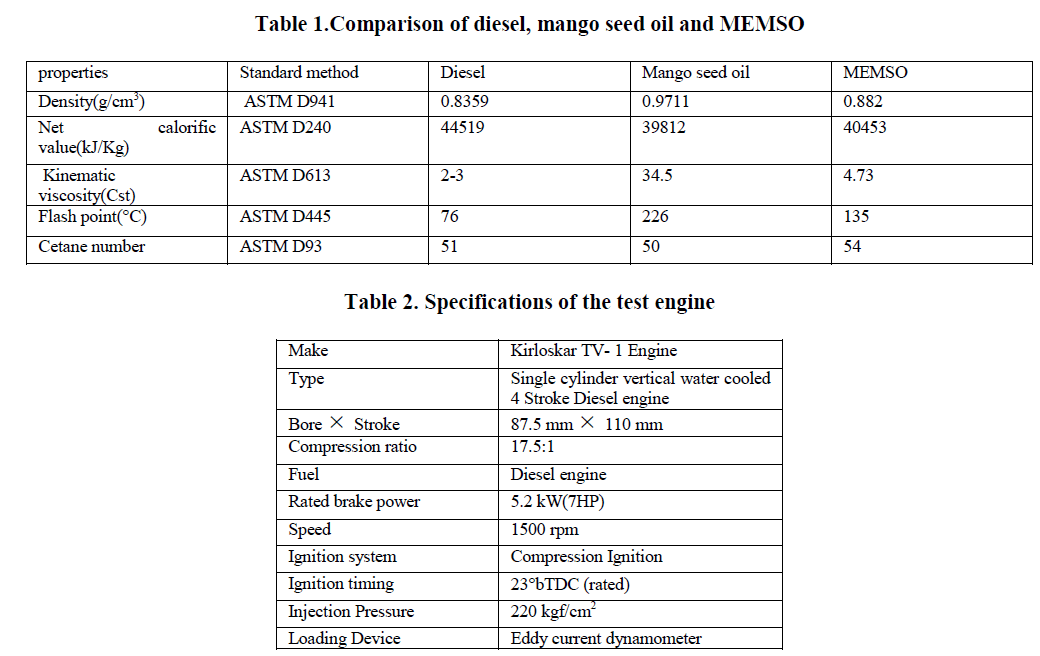 |
RESEARCH METHODOLOGY |
| 3.1 Evaluation Method: The evaluation part plays an important role in this research. The main reason to choose the evaluation is, it is the only possible way to study the practical behavior of the decision model by assuming initial input values and priorities from decision maker (In this thesis authors are decision makers) [7][8]. In the evaluation method first phase is to structure the model with the help of goal, criteria and alternative. The second phase is to apply the decision rules, this is entirely dependent on the type of the decision model we are evaluating, for e.g. decision rules followed by ANP and AHP model. |
| A nine-point scale was employed with a score of 1 equal importance 3 moderate importance of one over another 5 strong or essentialimportance 7 very strong or demonstratedimportance 9 extreme importance2,4,6,8 intermediate valuesuse reciprocals for inverse comparisons as shown in Table 3. |
| 3.2 Procedure of data analysis: After tabulation of collected data and used AHP and ANP methods |
(A)Analytic Hierarchy Process (AHP) Method |
| "Analytical Hierarchy Process (AHP) is an approach to decision making that involves structuring multiple choice criteria into a hierarchy, assessing the relative importance of these criteria, comparing alternatives for each criterion, and determining an overall ranking of the alternatives”. |
| Main steps involved in AHP |
| (1) Organizing problem hierarchically |
| (2) Development of judgment matrices by pair wise comparisons |
| (3) Calculating local priorities from judgment matrices |
| (4) Alternatives ranking: global priorities (including global weights and global scores) |
(B) Analytic Network Process (ANP) Method |
| The Analytic Network Process is a methodology that allows groups or individuals to deal with the interconnections (dependence and feedback) between factors of complex structure in decision making process. Analytic Network Process (ANP) is a Multi-criteria decision making method that can be applied in various management and technical related decision problems. ANP is more generalized form of AHP [8]. One can easily understand ANP when it is compared with AHP. |
| The step by step process of ANP is as follows. |
| Step1. Structure the problem: This step involves in stating the problem clearly and decomposing the problem into a network like structure. |
| Step2. Pairwise comparisons: Decision elements at each cluster are compared pairwise with respect to their importance towards their control criteria. Also, interdependencies among criteria of a cluster are examined pairwise; the influence of each element on other elements is represented by an eigenvector. The relative importance values are determined with Saaty’s scale [17]. |
| Step3. Super matrix formation: To obtain global priorities in a system with interdependent influences, the local priority vectors are entered in the appropriate columns of a matrix. A super matrix is a partitioned matrix, where each matrix segment represents a relationship between two clusters in a system. |
| Step4. Synthesis of the criteria and alternatives’ priorities and selection of the best alternatives: The priority weights of the criteria and alternatives can be obtained from the normalized super matrix. |
DATA ANALYSIS |
3.1 ANP Method to select the best material for an axle in motorcycle |
| AHP approaches to selection of the best material for an axle in motorcycleThe criteria considered in selection process are Cost of raw material, Hardenability of raw material, Availability of raw material, Chemical Composition of material, and Mechanical Properties (Yield strength) of material. Table 3 shows the conversion scale or Saaty’s scale [17]. |
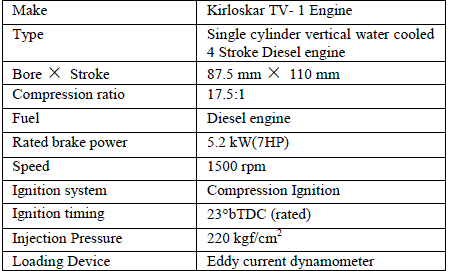 |
| After this, calculate the weightage of alternatives by pair wise comparisons of alternatives and calculate the weightage of alternatives with each criteria. The combination of the weightage vectors obtained by pair wise comparisons of alternatives as shown in Table 7.Priority Score of alternatives is shown in Table 7 and figure 1. With the help of Priority Score, developed the ranking of Alternative Material as shown in Table 8. |
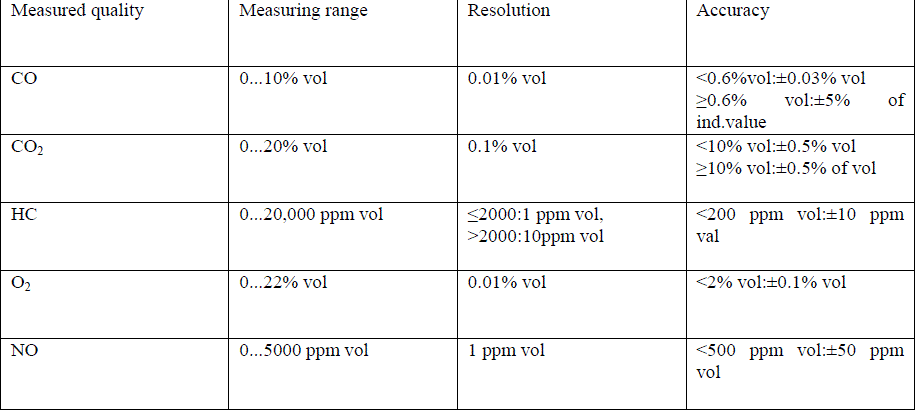 |
| Result of AHP: From Table 8, calculation to select the best material for an Axle in motorcycle by using AHP, we find that alternative 3 i.e. material AISI-4135 is best alternative for an axle and after that the material AISI 51B37, AISI 15B25,AISI 10B21, AISI 302 and AISI 304 are the best alternative in ascending order of their rank. |
3.2 ANP Method to select the best material for an axle in motorcycle |
| In order to select the best material for an axle by using ANP method first we have to determine the pair wise comparison between alternative & alternative and criteria & criteria. By interviewing the R&D, Production, Quality, Maintenance, Sales staff and Management authority of motorcycle manufacturing companies and Axle manufacturer companies’ criteria and alternatives are taken into account. The main alternatives of materials those are used by the different manufacturers of motorcycles are AISI 15B25, AISI 10B21, AISI 4135, AISI 51B37, AISI 302 and AISI 304. The criteria considered in selection process are Cost of raw material, Hardenability of raw material, Availability of raw material, Chemical Composition of material, and Mechanical Properties (Yield strength) of material. |
| First we have to determine decision elements at each cluster are compared pairwise with respect to their importance towards their control criteria. Also, interdependencies among criteria of a cluster are examined pairwise; the influence of each element on other elements is represented by an eigenvector. |
| After that we have to obtain global priorities in a system with interdependent influences, the local priority vectors are entered in the appropriate columns of a matrix. A super matrix is a partitioned matrix, where each matrix segment represents a relationship between two clusters in a system as shown in Table 9. |
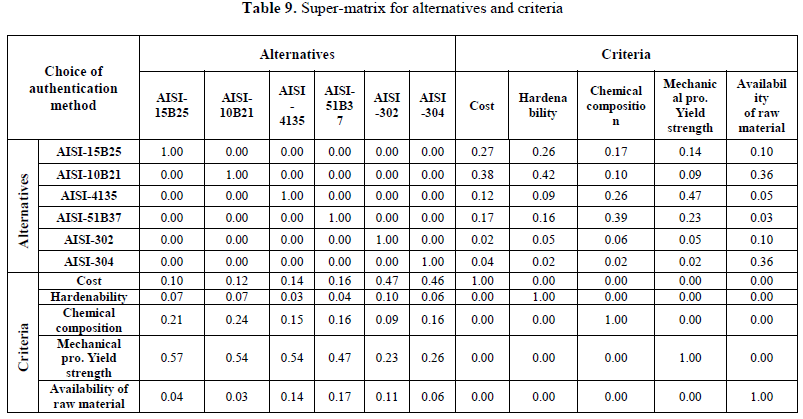 |
| The Synthesis of the criteria and alternatives’ priorities and selection of the best alternatives. The priority weightage of the criteria and alternatives can be obtained from the normalized super matrix. super-matrix, we can normalized the super-matrix and called weighted super-matrix (matrix A) and multiplying matrix A with matrix A up to 64 stages and developed Limiting Super-matrix for the alternatives and criteria. Table 10 shows synthesized or Limiting Global Super-matrix for the alternatives and criteria |
 |
 |
| Now from the obtained values from Table 10, need to form Eigen vector of the matrix and further need to normalize it. For normalizing the matrix of pair wise comparison, divide each element by sum of its own column after normalizing, normalized score will obtained which is shown in Table 11 and raking of alternative material shown in Table 12. |
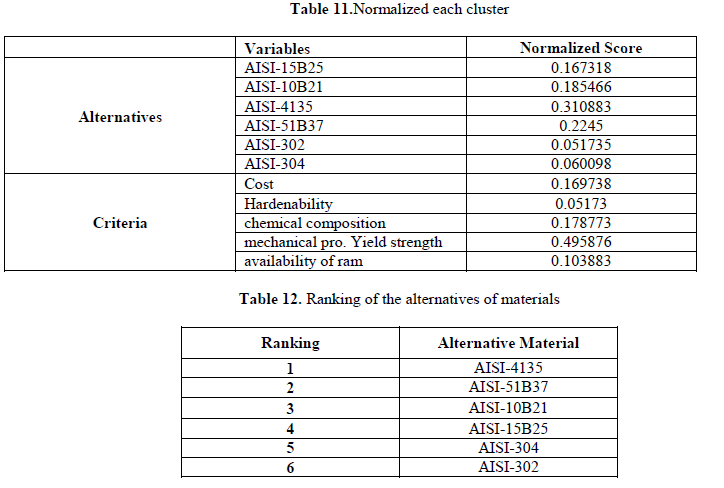 |
| Result of AHP: From Table 12, calculation to select the best material for an Axle in motorcycle by using ANP, we find that alternative 3 i.e. material AISI-4135 is best alternative for an axle and after that the material AISI 51B37, AISI 15B21,AISI 10B25, AISI 304 and AISI 302 are the best alternative in ascending order of their rank. |
CONCLUSION |
| The choice of material for a particular product is a challenging task, as the selected material directly determines the visible quality and the cost of the product. Material selection is a continuous process, aiming to choose the best material for a given application to satisfy a predetermined set of requirements. The material selection decision is made during the initial design stage of the product life cycle, i.e., when the component is first designed or when it is redesigned. An incorrectly chosen material can lead not only to a premature failure of the component, but also to an unnecessary cost. At present, numerous engineering materials exist than even before. The main purpose of material selection process is to recognize the predominant selection criteria and then to obtain the most appropriate combination of those conflicting criteria according to the requirements. |
| In this research work an attempt has been made to aid the axle manufacturing companies and the motorcycle manufacturing companies to select a best material for an axle by using AHP and ANP method. Table 8 and Table 12 is the result of AHP and ANP and we find that alternative 3 i.e. material AISI-4135 is best alternative for an axle and after that the material AISI 51B37, AISI 15B21,AISI 10B25, AISI 304 and AISI 302 are the best alternative in ascending order of their rank. |
| In future studies, other multi-criteria methods like fuzzy AHP, TOPSIS, and fuzzy PROMETHEE can be used to handle material selection problems. |
References |
|